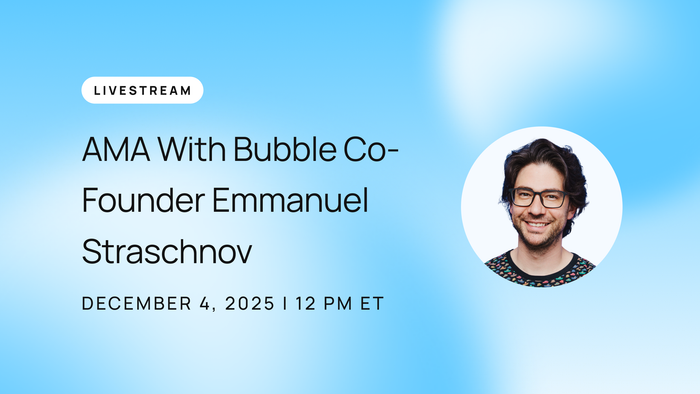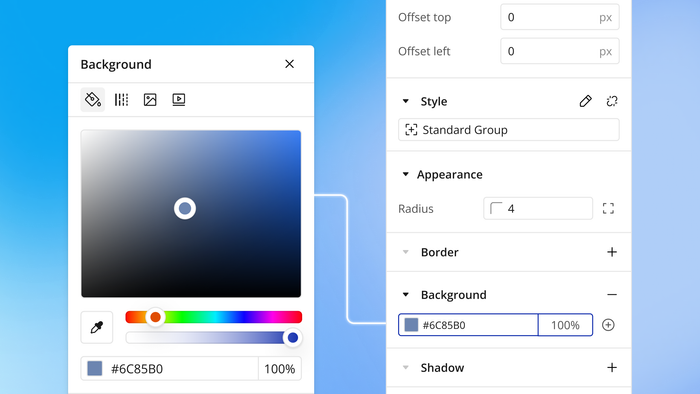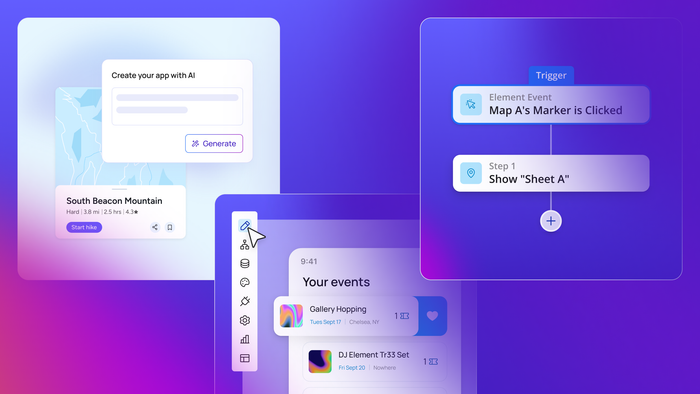WordPress is an open-source, no-code software for building websites and blogs. Released in 2003, WordPress was a forerunner of today’s no-code tools. Individuals and businesses alike use WordPress software to build and develop websites, blogs, marketing sites, landing pages, and more. For more experienced coders and developers, you can self-host your own website via WordPress.org. Beginner builders will likely want to use the web app version at WordPress.com to get managed hosting and security.
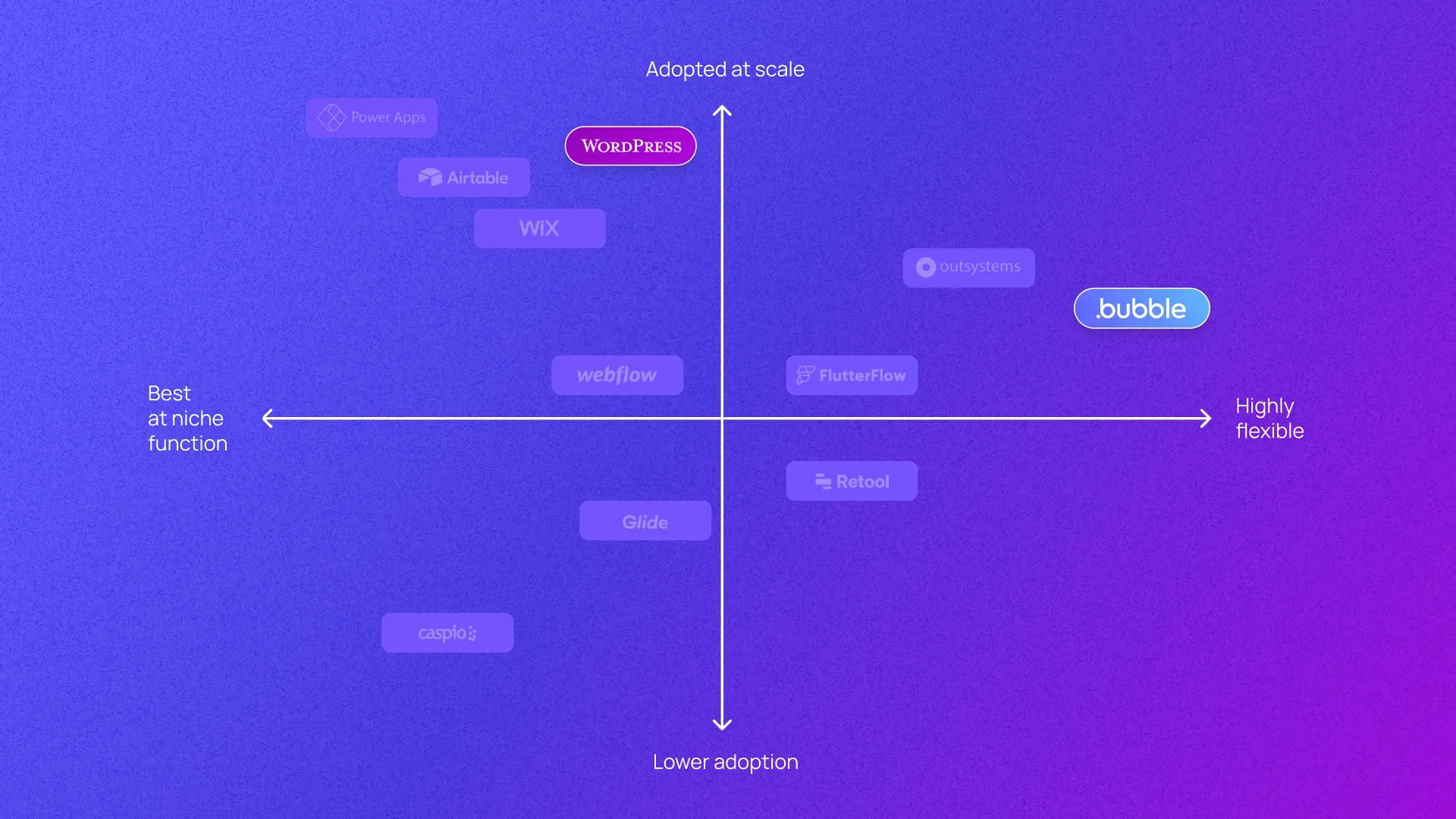
Bubble is a no-code application development platform that lets you build anything — from simple websites to complex web and mobile applications and your own software — without having to code. With over 5 million websites and apps built on Bubble, it’s a secure, proven way to develop and launch apps of all kinds.
Either platform may work for your project, depending on your use case and experience level. WordPress is primarily used for creating websites and blogs. However, users tend to use Bubble for:
- Complex, fully-functional web apps
- Unlimited customization options without having to code
- Unlimited use cases and versatility
- True no-code experience — only use custom code if you want to
- Stricter compliance standards and security
- A rich community and ecosystem to extend and support your app
- An easier learning curve and, as many users on the Bubble forum say, a fun building experience compared to WordPress
Both are great tools, but have very different use cases, which can also make them good complements for one another. Many users use Bubble and WordPress together, with Bubble powering their app or digital product and WordPress powering their static website. It’s a great way to leverage the strengths of each tool!
Of course, we are Bubble, and so naturally, we’re big fans of our own visual programming tool. That’s why we tapped the wider no-code community to find out what mattered most to them when choosing a platform. Then we used their responses to develop a rubric that more objectively compares Bubble to solutions like WordPress.
In this article, we’ll show you how these two platforms stack up — and you’ll see why no matter what you’re trying to build, Bubble is a fantastic option. If you want to learn more about the process of choosing the right tech for your use case, check out our full buyer’s guide to 23 different no-code development platforms.
WordPress vs. Bubble: At-a-glance comparison
Let’s start with a high-level overview of how Bubble and WordPress compare.
| WordPress | Bubble | |
|---|---|---|
| Common use cases | WordPress is a popular solution for building static websites, such as e-commerce sites and blogs. | Bubble is perfect for any type of feature-rich web or mobile app with complex functionality. |
| Where they shine | WordPress is well-known for being a beginner-friendly way to create simple sites, or offering an open-source platform for coders for more complex projects. | Bubble gives non-technical founders and experienced developers no-code tools to build anything quickly. |
| Overall score | ⭐⭐⭐⭐ (3.95) | ⭐⭐⭐⭐ (4.00) |
| Use-case versatility | 🟩🟩🟩🟩⬛ | 🟩🟩🟩🟩🟩 |
| Full-stack coverage | 🟩🟩🟩🟩🟩TKTK | 🟩🟩🟩🟩🟩 |
| Performance | 🟩🟩🟩🟩🟩 | 🟩🟩🟩🟩⬛ |
| Ecosystem | 🟩🟩🟩🟩🟩 | 🟩🟩🟩🟩⬛ |
| Cost | 🟩🟩🟩🟩⬛ | 🟨🟨🟨⬛⬛ |
| Customizability | 🟩🟩🟩🟩⬛ | 🟩🟩🟩🟩⬛ |
| Compliance | 🟥🟥⬛⬛⬛ | 🟩🟩🟩🟩⬛ |
| Code ownership | 🟩🟩🟩🟩⬛ | 🟨🟨🟨⬛⬛ |
| Learning curve | 🟥🟥⬛⬛⬛ | 🟨🟨🟨⬛⬛ |
| Resources | 🟩🟩🟩🟩⬛ | 🟩🟩🟩🟩⬛ |
| Community | 🟩🟩🟩🟩⬛ | 🟩🟩🟩🟩🟩 |
We wanted to compare these platforms based on what matters most to actual no-code developers — so we asked them. In our 2024 State of No-Code Development Survey, more than 350 no-code founders, developers, freelancers, and hobbyists rated the importance of 17 factors when choosing a no-code builder. We developed these categories using their feedback.
In the fall of 2024, we scored Bubble and WordPress from 1–5 in each of these areas, with 5 being the best score. Each score had specific requirements, and we’ll explain more about those below.
We also gave each platform an overall score using a weighted average. This was based on how important the category was to no-code developers in the survey. Here’s how Bubble and WordPress compared.
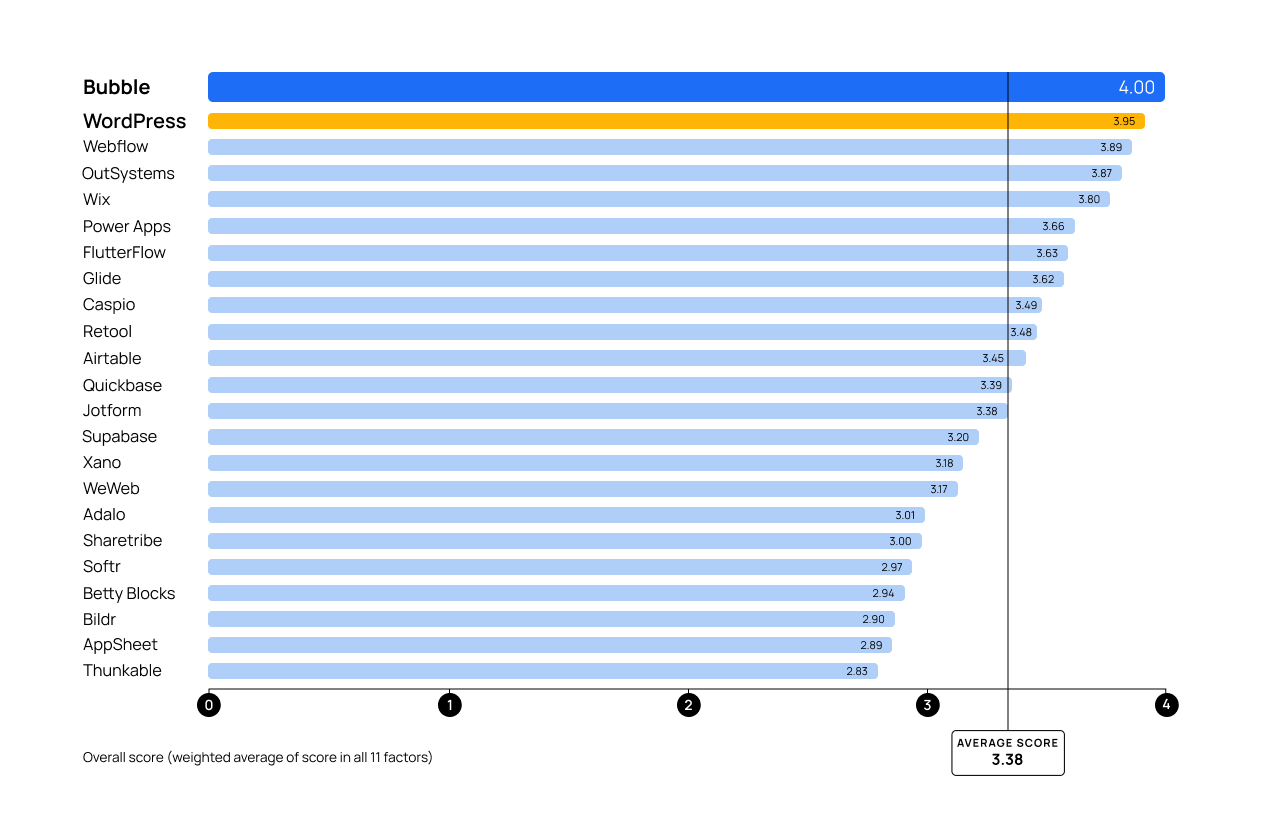
WordPress vs. Bubble on use-case versatility
When a platform is generally used for a specific purpose — for example, to build websites or to build specific types of apps, like business tools — it eventually limits what you can do with that app. The platform’s parent company will likely be inclined to focus on features for those use cases, and in time, the platform becomes amazing for a specific purpose and more difficult to use for other purposes.
Other platforms are more open-ended — they’re used for many, many different purposes and across various industries, which makes them more flexible. They often give you more of a blank slate.
Neither of these are right or wrong, but understanding how your no-code platforms are generally used will give you a good idea of what you might be able to achieve with them. Our scores for use-case versatility try to take this into account, rating each platform based on the range of use cases most people use them for.
Bottom line: Bubble offers the most versatility across industries and use cases — you can build anything you can imagine. WordPress offers a lot of versatility across the types of websites you can build, but more complex use cases can become difficult.
| Score | Criteria |
|---|---|
| 1 | Not particularly well-known or well-perceived by the market for any use cases |
| 2 | Narrow set of use cases as perceived by the market |
| 3 | Use-case versatility across app types or industries, but not both. |
| 4 | Use-case versatility across either app types or industries, with some use-case versatility in the other category |
| 5 | Shown to be proficiently versatile across both app types and industries |
How WordPress stacks up: It’s no secret that WordPress’ software powers a lot of the internet (by some estimates, around 40%!). So it’s clear that WordPress is sufficiently versatile across industries, and somewhat versatile across types of sites or apps as well.
WordPress users use it to build static websites, marketing sites and landing pages, portfolios, blogs, e-commerce sites, and more. At its heart, WordPress is a CMS (content management system), so it’s best for creating content-heavy sites where the majority of end users are reading and interacting in basic ways with content.
However, with some custom code, plugins, and technical know-how, you can build more advanced features and functionality to create more interactive web apps or websites.
WordPress’ versatility score: 4/5
How Bubble compares: Bubble’s versatility is one of its greatest strengths. While WordPress shines for website design, Bubble shines when it comes to complex, fully-functional web or mobile apps.
With nearly 5 million apps created on Bubble, you’ll see a ton of use cases — from websites and one-off landing pages to marketplaces, social media apps, industry-specific apps and business tools, SaaS tools, and more. You have the flexibility to build different kinds of software in a wide range of industries, and it shows in the kinds of products our users create. For example, Bubble users have built:
- A personalized health and wellness marketing and e-commerce site
- A personal global investments platform
- A programmatic SEO tool
- A document-processing app that uses AI computer vision to extract data from documents automatically
- A mobile-first EdTech tool to make learning more engaging
- A curated events marketplace for teams
Website builders lack the power and flexibility needed for critical features of many of these apps — but Bubble’s open-ended, no-code builder gave these founders all the options they needed, and more.
Bubble’s versatility score: 5/5
WordPress vs. Bubble on full-stack coverage
When it comes to software development, there are three main pieces of your “tech stack” you need to cover: design (the frontend), data (the backend), and logic (the workflows that connect those two pieces and make your app work). But many no-code platforms only focus on one or two of these areas, and they can’t give you access to the entire stack.Our scoring criteria for this category focuses on how much of the development process the platform lets users access — in other words, how close the platform is to being a “full stack” solution.
Bottom line: Bubble offers full-stack capabilities and complete control over all three without having to code. WordPress offers full-stack capabilities, but it requires some technical expertise to really edit and manage databases.
| Score | Criteria |
|---|---|
| 1 | Capabilities in one area: design, data, or logic |
| 2 | Capabilities in one area, gives user limited access to another |
| 3 | Capabilities in two areas |
| 4 | Capabilities in two areas, gives user limited access to the third |
| 5 | Full-stack: Capabilities in design, data, and logic |
How WordPress stacks up: WordPress offers full-stack capabilities. Design is managed via their visual interface. You can also add and manage data on your website via WordPress Database, which is powered by MySQL. Logic between the two is managed by pre-built components or by writing code.
Although WordPress offers full-stack functionality, editing or customizing the database requires knowing (or learning) SQL commands and learning how to navigate a separate interface like phpMyAdmin. For experienced developers, this won’t be a problem, but for non-technical founders and builders, this can be more of a learning curve that you might expect.
The good news is that for more WordPress uses (i.e., websites and e-commerce sites), interacting with the database directly isn’t necessary. You can use pre-built components and plugins to add basic functionality without having to code.
WordPress’ stack coverage score: 5/5
How Bubble compares: Bubble is one of the few full-stack development platforms on the market that offers you complete control over your software’s design, data, and logic without having to code.
On Bubble, you can fully customize the look, feel, and functionality of your app all from Bubble’s visual editor. As a result, you can use Bubble as a frontend-only solution (i.e. design and logic with a separate backend), for a backend-only solution (i.e. use WordPress for your frontend and Bubble for database and logic), or use Bubble as an all-in-one solution.
The benefit of a true all-in-one solution with Bubble is that you aren’t required to manage separate platforms to build your app, you only need to pay for one for one tool, and you aren’t required to learn multiple interfaces or programming languages to build your entire, functional app.
Bubble’s stack coverage score: 5/5
WordPress vs. Bubble on performance
Performance isn’t flashy, but it’s one of the most important elements of your no-code platform. After all, your own website or app can only be as reliable as the software or platform you build it on.
When comparing Bubble and WordPress, we took into account how the platform performs as you scale up server demand. That is, can the platform grow with you, or does performance take a hit when your user base grows too large?
Bottom line: Bubble and WordPress both offer stable, scalable solutions. Just keep in mind that while WordPress.com has reliable hosting with rare outages, self-hosted WordPress performance will vary completely depending on the hosting platform you choose.
| Score | Criteria |
|---|---|
| 1 | Frequent outages |
| 2 | Outages scale with user growth and/or company has no status page |
| 3 | Infrequent outages, but communicated with limited transparency to the user or sporadic outages, but quickly and transparently addressed |
| 4 | Infrequent outages, with any that do occur quickly and transparently addressed |
| 5 | Rare outages |
How WordPress stacks up: WordPress.com offers stable and reliable hosting, with strong performance. Outages are rare and resolved quickly when they do occur, and they have a status page with incident history available for users and non-users.
If you’re self-hosting via WordPress.org, then your performance will vary based on the hosting platform you choose.
WordPress’ performance score: 5/5
How Bubble compares: At the time of this article’s publication, Bubble had a 99.88 % uptime over the last 90 days. As such, Bubble rarely experiences outages, especially ones that affect a large number of users. But if they do happen, our team does two things especially well:
- We detect and resolve the issue quickly to get you back online.
- We clearly communicate what’s happening and what we’re doing about it, so you’re never in the dark.
We know that our operations directly impact yours, so we heavily invest in our network infrastructure and react fast to unforeseen issues. If you’re experiencing an issue, start by checking Bubble’s status page. You can also keep up to date on outages via @BubbleStatus on X and the Bubble forum.
Bubble’s performance score: 4/5
WordPress vs. Bubble on ecosystem
No-code platforms aren’t islands: Each comes with an ecosystem of third-party tools, services, partnerships, and so on that can extend the capabilities of a platform. Ideally, you want a no-code tool with a rich ecosystem that’s easy to use.
Our ecosystem quality scores are based on what third-party services a vendor offers, the third-party products that have been created, how accessible they are, and what partnerships they have.
Bottom line: Bubble and WordPress both provide strong ecosystems that are simple to use. One distinction to keep in mind is that WordPress relies more strongly on plugins to extend the no-code capabilities of its software, while Bubble offers more built-in functionality.
| Score | Criteria |
|---|---|
| 1 | Minimal third-party services that are challenging to use |
| 2 | Minimal third-party services, but they’re easier to use |
| 3 | Robust third-party services, but they’re challenging to use |
| 4 | Strong strategic partnerships; robust third-party services, but not perfectly seamless |
| 5 | Strong strategic partnerships; robust third-party services that are easy to use |
How WordPress stacks up: WordPress.org is an open-source software, which means that although the primary software engine may seem basic compared to other builders, the ecosystem around it — added by other developers — is huge.
You can find plugins and integrations for almost any aspect of your website or functionality, and with almost 60,000 plugins in the WordPress marketplace, it’s unlikely you’ll have to build your own (unless you want to). The downside of this, of course, is that on WordPress, too many plugins — especially low-quality ones — can slow your site down, yet they’re essential for getting full functionality out of your WordPress site without having to custom code.
WordPress also has thousands of templates (usually called “themes”) so you don’t have to design your website from scratch.
WordPress’ ecosystem score: 5/5
How Bubble compares: Bubble’s ecosystem also offers thousands of plugins and templates to help you extend the platform and build any look or features you want.
The biggest benefit of these third-party features is that you can connect your software to other tools without having to code integrations yourself. (Of course, if you want to and know how, you can absolutely code your own plugins as well.)
Plus, the Bubble community’s massive collection of templates also helps you build the pages, layouts, workflows, and designs you want even faster. And Bubble has strategic partnerships with startup programs and universities including Microsoft For Startups, Harvard University, and Columbia University.Need to hire someone to build your app? Bubble’s agency database helps you filter and compare agencies that use Bubble by experience, services, cost, language, and region, so you can quickly find a partner that’s right for your project.
Bubble’s ecosystem score: 5/5
WordPress vs. Bubble on cost
The cost grades we gave WordPress and Bubble consider the cost of using the tool, with higher scores reflecting lower costs. While there are many factors that impact cost, we primarily took into account the pricing model, the platform’s price, and how much free access the vendor allows.
Bottom line: WordPress’ pricing starts at very affordable rates, but many users find the limited templates, features, and functionality at lower plans restrictive. Bubble’s pricing has fewer tiers and less restrictions, so you can use all the features of the platform without having to continuously upgrade or pay for additional plugins.
| Score | Criteria |
|---|---|
| 1 | No free tier |
| 2 | Free tier, deployment on custom domain costs more than $50 per month |
| 3 | Free tier, deployment on custom domain costs less than $50 per month |
| 4 | Free tier, deployment on custom domain costs less than $10 per month |
| 5 | Free deployment on custom domain |
How WordPress stacks up: Your cost with WordPress ultimately varies a lot depending on what you build, what plugins you need, and how you host and manage your website.
For example, with WordPress.com, you can use the WordPress software to build a website and host it on WordPress servers. Plans start at $4 per month, when paid annually, and can reach $25,000+ annually for Enterprise-level plans.
If you decide to self-host (using WordPress.org software), your costs will vary depending on your hosting service and plan, your domain name costs, any templates and plugins you purchase to power your site, and more. All of this can vary a lot, so you can keep your costs pretty low, or they can easily exceed hundreds of dollars per month.
WordPress.com also offers a free plan, which comes with limited features and functionality, plus ads and WordPress branding on your website.
WordPress’ cost score: 4/5
How Bubble compares: By comparison, Bubble’s pricing is a lot simpler. Bubble offers a Free plan, which gives you all the access to the platform you need up until you launch your app for users.
From there, paid monthly plans vary based on the workload demand for your software, the capabilities you need, and the number of people working on your app.
Put simply: Bubble servers have to scale with your app as it grows, and that means pricing does, too. Plans start at $29 a month.
Bubble’s cost score: 3/5
WordPress vs. Bubble on customizability
Customization is a key element of no-code builders. After all, you want your website or app to look and function exactly as you imagine it, right? But many platforms can only be fully customized by writing code — which somewhat defeats the point of a no-code app.
Ideally, no-code platforms should offer complete (or at least robust) customization options within the no-code editor itself, while also providing options to use custom code as desired.
In this comparison, our customizability scores are based on how flexible a platform is — both in terms of what you can build with it, and how easy it is to add new features throughout your software’s lifecycle. We also considered whether the platform makes customization easier with AI.
Bottom line: Bubble is more customizable than WordPress, and it requires less technical expertise to do so. On Bubble, you have full control over all design and functionality of your site or app, and you don’t have to use custom code. On WordPress, many customizations are difficult or require you to write custom code to make them.
| Score | Criteria |
|---|---|
| 1 | Minimal ability to customize frontend, minimal ability to add new functionality, high level of difficulty to build beyond templates |
| 2 | Customizable frontend, minimal ability to add new functionality, limited generative AI assistance |
| 3 | Customizable frontend, open to adding new functionality, robust frontend AI use cases |
| 4 | Everything from 3, plus AI-generated logic and data schema |
| 5 | Everything from 4, plus conversational editing that allows for entire AI-generated apps |
How WordPress stacks up: WordPress is super customizable, especially if you’re using WordPress.org software and hosting on your own. You’re less locked into WordPress.com pricing plans for feature and customization access, and you can add custom code to achieve the look and functionality you want.
The only problem is that many customizations on WordPress require you to add custom code, primarily using PHP (the programming language WordPress is built on). Even for experienced developers, custom WordPress development can be a bit of a challenge — or at least require some real time and effort to become comfortable with.
WordPress’s customizability score: 4/5
How Bubble compares: Customization is an area where Bubble really shines. You can build just about anything, and you can add whatever capabilities you want, either within the Bubble editor itself or through our API Connector.
Many WordPress users — especially if you don’t have strong coding knowledge — find WordPress templates and themes limiting. Customization options can be limited by plan tier (if you’re on WordPress.com), or they can be needlessly complicated and require custom code.
Bubble’s customizability is limitless for both functionality and design, and you never have to use custom code. It’s always an option for those who want to, but it’s never required — and that’s what really sets Bubble apart from many website and app builders available right now.
Even better: You can use Bubble’s AI app generator make building and customizing web pages and web apps even simpler. Just describe what you want to create to our AI assistant, and the tool will interpret your prompt and suggest layouts, features, and functionality you might want to use. It’ll even give you guides for how to edit and adjust the suggested options to create exactly what you’re looking for.
Bubble’s customizability score: 5/5
WordPress vs. Bubble on compliance
Websites and web apps store lots of data — from you, your company, and your users. For that data to stay secure, you need to build on a secure development platform and maintain a secure app or website.
Checking the built-in compliance standards of your platform will help establish a baseline for security capabilities, and you can often harden a platform with additional security features as needed.
Our compliance scores are based on which standards a platform complies with (by default) and whether it offers a path to compliance with additional standards. Higher scores correspond to more sophisticated standards.
Bottom line: Bubble offers much stronger built-in security and compliance than WordPress does. With WordPress, your site is basically only as compliant and secure as you specifically make it.
| Score | Criteria |
|---|---|
| 1 | No stated native compliance certifications |
| 2 | No native compliance certifications, but either 1) can be made compliant with plugins or 2) gives instructions for hosted apps to become compliant by themselves |
| 3 | SOC 2 Type I compliant |
| 4 | SOC 2 Type II compliant or ISO 27001 compliant |
| 5 | SOC 2 Type II compliant and HIPAA compliant |
How WordPress stacks up: WordPress’ out-of-the-box compliance varies a lot depending on how you’re hosting.
If you’re self-hosting, then you’re fully responsible for all server security, compliance, management, and so forth. You’ll need to have the technical knowledge and expertise on your own to make (and keep) your site secure.
WordPress.com sites don’t have native compliance certifications, but they do provide resources for making your website compliant with GDPR. Websites by default aren’t SOC 2 Type II or HIPAA compliant, and making them so can be a challenge. However, other hosting platforms that allow you to self-host a WordPress website may offer stronger compliance.
Bottom line: WordPress doesn’t offer built-in compliance, so you’re on your own to know what level of security your site will need and create that, either via a WordPress plugin, your server, or both.
WordPress’ compliance score: 2/5
How Bubble compares: Bubble has built-in compliance with SOC 2 Type II Type II, which means it can easily pass long-term security audits. Plus, every Bubble pricing plan comes with access to some or all of Flusk’s best-in-class security-check features.
Besides the basics, we’ve also implemented numerous solutions to further protect your data. If you want to build an app that complies with more advanced standards like GDPR or HIPAA, these compliance articles explain how to follow these standards when you build with Bubble.
Bubble’s compliance score: 4/5
WordPress vs. Bubble on code ownership
Even if you’re planning on sticking with a platform long-term, you never know when you might need to migrate elsewhere. Perhaps the platform doesn’t meet your needs anymore, or you want to expand the project, or the platform even shuts down. In any case, it’s helpful to go into a project knowing what you can take out of the platform if you move on someday.
Our scoring criteria for the ownership category are based on how much freedom a platform gives you to export your work — specifically your code and your data.
Bottom line: Bubble and WordPress both allow you to export data at any time. WordPress allows you to export some code as well, in XML format.
| Score | Criteria |
|---|---|
| 1 | No exports supported |
| 2 | Allows partial data exports |
| 3 | Exports data, but not code |
| 4 | Exports data and code, but in limited languages and formats |
| 5 | Exports all data and code |
How WordPress stacks up: WordPress generally allows for exports in XML format. Keep in mind that although this includes your website’s posts, data, pages, and so on, it won’t include source code for WordPress themes or plugins.
If you have a WordPress Business or Commerce plan, you can use a plugin to export your entire site, including themes and plugins, to another hosting provider or a self-hosted option. This can be a bit more complicated, but it is possible.
WordPress’ code ownership score: 4/5
How Bubble compares: On Bubble, you can always export all of your data freely, but you can’t export code.
That’s because on Bubble, the “code” of your no-code app is powered by our platform’s proprietary source code, so we can’t export code for your app without either releasing our source code too, or separating the two and therefore breaking your code.
Our promise to our customers, however, is that if your organization outlasts Bubble, we’ll release our source code under an open-source license.
Bubble’s code ownership score: 3/5
WordPress vs. Bubble on learning curve
Learning to build with no-code will always be easier than learning traditional coding — but that doesn’t mean it’s effortless. Every platform uses no-code in different ways, so you’ll have to factor in the learning curve and specific nuances of each platform to understand how simple your project will feel.
Some platforms require technical expertise to even get started with, while others can have even non-technical builders up and running in less than an hour.
Our learning curve scoring criteria is based on how difficult a platform is to learn and how fast you can start building.
Bottom line: WordPress is easy to make something simple, but requires custom code and much more technical knowledge for customization or complex projects. Bubble is simple to get started with no matter what you’re making and provides an intuitive, truly no-code editor for all aspects of the process.
| Score | Criteria |
|---|---|
| 1 | Extremely difficult to learn (comparable to learning code), demands significant technical knowledge, extensive time investment |
| 2 | Very difficult to learn, demands strong understanding of logic and some technical familiarity, extensive time investment |
| 3 | Moderately difficult to learn, demands moderate technical familiarity, moderate time investment (courses, tutorials, community support, etc.) |
| 4 | Somewhat easy to learn, demands minimal technical familiarity, allows you to start building on your first day |
| 5 | Extremely easy to learn, no technical familiarity needed, allows you to build something in your first hour |
How WordPress stacks up: Although it can be pretty simple to get a basic landing page or blog up and running with a default WordPress theme, going further than that — doing any kind of customization, adding more functionality, or making a more complex website or user experience — can be challenging.
WordPress development requires some knowledge of PHP (especially for database development) and potentially HTML/CSS as well, depending on your design needs, what plugins you want to use, and how much customization you’re after.
In short: Building a simple website on WordPress is pretty straightforward. Building anything more customized or complex requires a steep learning curve, even for those with more technical expertise.
WordPress’ learning curve score: 2/5
How Bubble compares: Bubble is incredibly easy to get started with, especially with Bubble’s AI tools. Even without AI, Bubble’s intuitive interface makes everything from frontend design (i.e., creating the pages of your website or app) to building workflows and logic (i.e., deciding how your app will work) a simple drag-and-drop.
Of course, as with any tool or platform, learning all the ropes and gaining true expertise takes time. A technical background can help you get more from the platform, faster, but you don’t need any experience to hit the ground running.
As you build, manage, and iterate on your app, you’ll get more familiar with Bubble and become more proficient in it (and learning Bubble is much quicker and easier than learning how to manage AI-generated custom code.)
Plus, we’ll give you lots of resources and paths to learn, and you can always start from a template to quickly turn straightforward ideas into fully-developed apps. A technical background helps you get more from the platform, faster, but you don’t need experience to hit the ground running.
Bubble users put it this way:
“I find doing anything complicated in WordPress to be extremely difficult. In Bubble, I can create pages that work exactly how I want them to work much more easily.” - @dannycvega
“Currently in the process of moving from WP to Bubble for one of my projects. Definitely not looking back… Bubble requires a little more upfront investment – you need to invest some time to create your own publishing backend, a categories/tags system, and to be thoughtful about creating user permissions if you want different publishing rights. But I think it’s well worth the long-term customization benefits.” - lsy
Bubble’s learning curve score: 3/5
WordPress vs. Bubble on education and documentation resources
As you build, having the right resources at hand is essential. Whether you’re an experienced developer or a non-technical founder, you can’t be expected to figure everything out on your own — and shouldn’t have to.
A good no-code platform has robust self-guided education options, technical support, and platform documentation to help you learn something new, figure out a feature, or troubleshoot challenges.
Our scores for a platform’s resources are based on how much first-party educational materials it has — like guides, tutorials, and technical documentation.
Bottom line: Both Bubble and WordPress offer robust, high-quality documentation for learning. WordPress offers a wealth of support guides and technical documentation, while Bubble offers more content for various skill levels and learning types.
| Score | Criteria |
|---|---|
| 1 | Low-quality educational resources |
| 2 | Medium-quality resources |
| 3 | High-quality resources, low coverage |
| 4 | High-quality resources, medium coverage |
| 5 | High-quality resources, comprehensive coverage |
How WordPress stacks up: WordPress offers robust resources, mostly in the form of high-quality webinars and a strong support guide and documentation. They also offer step-by-step tutorials for their most common use cases, such as creating blogs and websites.
Because WordPress is a long-established software, you can also find lots of third-party resources for anything you can’t find from WordPress directly, such as YouTube channels and blogs, that will help you get started, troubleshoot various steps or tasks, or provide step-by-step walkthroughs.
WordPress’ education and documentation score: 4/5
How Bubble compares: Bubble offers a huge library of both high-level educational content and technical support documentation. Whether you’re curious about best practices for UI or UX design, or need to find a way to make a specific feature work on Bubble, we’ve got you covered.
We also have guides and documentation for various skill levels and types of learning styles. To that end, you can find hundreds of videos, dozens of step-by-step tutorial articles, a comprehensive online user manual, and a series of independent courses or cohort-based bootcamps for getting started.
Plus, our Bubble Developer certification program is an excellent way to become an expert in the platform.
Bubble’s education and documentation score: 4/5
WordPress vs. Bubble on community
Community is an important (and sometimes underrated) aspect of a no-code platform. Alongside documentation and resources, a strong community can give you recommendations, support, and feedback as you build, helping you when you get stuck or providing tips for how to build effectively.
It’s also worth asking: Is the vendor part of that community? The more actively involved vendors are in the communities that form around their platforms, the more aware they are of users’ needs and sentiments — and the more access you have to the people who make decisions about the platform.
Our scores reflect how active a platform’s developer community is and the degree to which the platform vendor participates in the community.
Bottom line: WordPress and Bubble both offer strong communities. No matter which platform you choose, you’ll have the support of a global community of builders and developers to turn to for feedback, learning, and troubleshooting.
| Score | Criteria |
|---|---|
| 1 | No community channels |
| 2 | Community channels exist, but participation is low |
| 3 | Active community, some company participation |
| 4 | Robust community, regular and valuable company participation |
| 5 | Everything in 4, plus in-person company events |
How WordPress stacks up: Since WordPress powers so many websites, you can find a massive community of WordPress developers and builders online, especially on independent channels like YouTube and Reddit. However, WordPress also offers a strong forum for developers, too. Keep in mind that there are separate forums for WordPress.com and WordPress.org. The .com forums are much more active, but they’re less organized and have fewer “solved” posts. The .org forums are more organized, but appear less active.
WordPress staff also provides regular support via the forum, especially for technical questions.
WordPress’ community score: 4/5
How Bubble compares: Bubble’s developer community is one of its greatest strengths. Not only does Bubble host a highly active forum where posts regularly see thousands of views and hundreds of comments, but Bubble users are also active on multiple subreddits, Discord groups, WhatsApp, Slack, Facebook, and more. In short, you can find Bubbler users just about anywhere you spend time online.
We also host in-person and virtual events, as well as our annual BubbleCon for builders and developers.
Bubble’s community score: 5/5
Bubble vs. WordPress: Which one is for you?
Bubble and WordPress are both no-code website builders that allow you to create beautiful websites without having to code it yourself from scratch. Both platforms offer full-stack coverage, a rich ecosystem and community, and strong performance. As evidenced by our comparison score data, Bubble and WordPress have similar overall scores, which points to the strengths of each platform.
However, that doesn’t mean these two platforms are interchangeable. Their use cases are very different, so you’ll want to carefully consider your use cases, your experience level, and your desired learning curve to pick the right platform for you.
WordPress is best for beginners who want to create a static website with basic features, either for a blog, a marketing website, or a basic e-commerce site. WordPress.com’s straightforward website building process, plus thousands of templates and resources for getting started, make building something simple relatively straightforward. It’s also easy to manage websites on WordPress.
You don’t have to customize your own database or create layouts for all of your pages — just build from a template and add your own content.
However, if you want to create something more complex, such as a more complicated website or a web or mobile app with interactive functionality, Bubble is the best option, particularly for people who don’t code.
Bubble offers a fully no-code way to create complex web apps and websites with unlimited features and functionality. Custom code is an option, but not a necessity, like it is with WordPress. Bubble also provides much more functionality within the foundational Bubble editor, which means you’re less reliant on plugins and integrations — although Bubble has a rich ecosystem of those if you need them as well.
The result is that Bubble allows you to create absolutely anything — from basic websites and blogs, to e-commerce sites, web apps with complex functionality, mobile apps, AI-powered apps, marketplaces and social media platforms, and more — all without having to code.
As such, Bubble is also much easier to learn to create complex sites and applications compared to WordPress. Bubble’s visual editor makes the design, database, and logic processes visual, which makes it much easier for non-technical builders and founders to get started and build whatever you envision. You’ll still need to invest some time and effort to get the most out of the platform, of course, but you don’t need a technical background to get started with Bubble.
And finally, for startups and enterprise builders, Bubble offers much stronger security and built-in compliance, and easier paths to upgraded compliance than WordPress does. WordPress leaves much of the security and compliance of your site up to you — or requires you to purchase and install plugins to help bolster security — whereas Bubble provides much stricter compliance right out of the box.
Want to see how Bubble compares to other no-code platforms? Check out some of our other comparisons:
Using Bubble and WordPress together
If you’re already familiar with WordPress, the good news is that you don’t need to throw out your expertise entirely if you’re interested in Bubble’s capabilities: Bubble and WordPress play nicely together and can be a great complement to one another.
Many people have built with Bubble and WordPress in tandem, usually with Bubble powering their app or digital software product, and WordPress powering a static or e-commerce marketing site for the product. This can be a great way to take advantage of WordPress’ quick and easy static website building tools, while also leveraging the power of Bubble’s web app functionality.
Of course, you can use Bubble for your marketing site or e-commerce site, too. So, which option should you choose?
Choose Bubble as a standalone option if:
- You want to keep everything in one place, including your app development, your databases, your customer data, your marketing site, your shopping and payment platforms. This can make development faster and make it easier to keep everything connected.
- You want to speed up development while keeping the brand aligned across your website and your product. Bubble’s styles and reusable components make it easy to align your branding across your website and your product without redesigning it from scratch each time. Copy and paste buttons, images, styles, fonts, headers, and more with a click.
- You want to keep costs down. Keeping everything on Bubble means one subscription (per app or website) and more features and functionality included with fewer plugin charges. WordPress plans can be inexpensive, but adding functionality and plugins can increase costs quickly.
Choose Bubble + WordPress if:
- You need a fully-functional web app and a marketing site, stat. A simple site built in WordPress with a pre-built theme can come together quickly, giving you more time to spend developing rich features for your app.
- You already have WordPress experience. If you’re a developer familiar with WordPress, it’ll likely be easy for you to build a website quickly within a familiar platform. Speed can be an advantage, and then you can spend more of your time and energy on features and functionality for your app on Bubble.
- You already have a WordPress site. Although some people will choose to migrate their WordPress site and content to Bubble to have everything in one place, you don’t have to. Use a REST API to connect your WordPress site and Bubble app, and you won’t have to rebuild (unless you want to).
Choose WordPress on its own if:
- You need a basic, static site for blogging or marketing. Blogs, portfolios, and the like can all be built quickly and easily on WordPress, and it’s a good choice for those options. You won’t go wrong choosing WordPress as long as you don’t need much customization from their templates and database designs!
Choose the no-code development platform that’s right for you
The no-code platform you choose completely shapes what your products and tools can actually do, the speed with which you can bring them to market, the ongoing impact development has on your budget, and the experience you’ll have for years to come.
Want to learn more about what goes into choosing a no-code development platform, along with a more detailed breakdown of the choices available to you? Check out our buyer’s guide to no-code development platforms.
The best way to decide which no-code platform is right for you? Try them yourself. You’ll see the difference, especially if you start with these comparisons in mind.
Build for as long as you want on the Free plan. Only upgrade when you're ready to launch.
Join Bubble

